Is Google biased against my practice? The spoiler alert answer is probably yes. It’s known as the Google Proximity Bias. It’s the focus of today’s Healthcare Marketing Rx. Our mission with this video series is to help the decision-maker of the practice, whether that’s the owner or the partner or the practice manager, a group of you help you make more informed decisions about marketing. Whether you’re thinking about starting some marketing, stopping it or changing it, we want to inform you with what good marketing looks like, so that when you contemplate spending money on it, you feel a bit more confident about the decision that you are making.
What’s the Google Proximity Bias?
Let’s start by telling you what this bias is. It’s commonly known as the “Google proximity bias”. Here’s the plain language definition:
When someone searches for what you do, your treatments, your services, the practices that are physically closer to the searcher are going to show higher in search results, all else being equal.
So in this video, we’re going to break down what this proximity bias looks like, and then show you some ways to fight back and turn everything else being equal into something unequal in your favor.
When the Google Proximity Bias Can Help You
There’s a good thing about the bias: if you are in the same city as the searchers who are searching for your treatments or your services, it can be a good thing. This is a map of a city in suburban Chicago named Palatine, Illinois. Palatine has about 68,000 people.
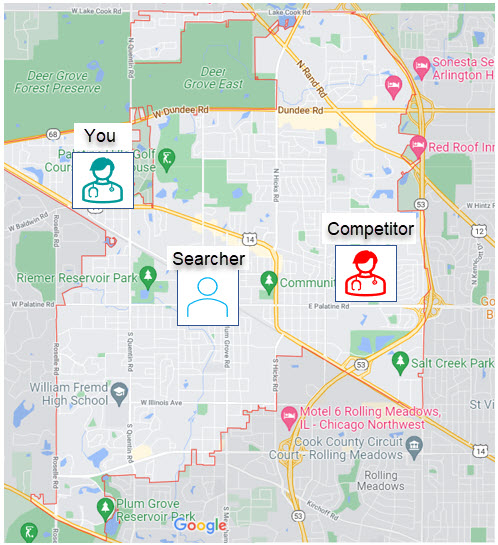
It’s a pretty good size. Let’s imagine that your practice is labeled “you” in the map, kind of in the Northwest corner. A “searcher” is searching for your treatments, your services, and you’ve got a “competitor”. You’re about equal distance.
All the things being equal, your website is good. Your SEO is okay. You haven’t done anything to really upset Google. When this person searches for your treatments, your services, you’ve got a good chance of showing up in their search results simply because you’re in the same physical city as the person doing the searching. Proximity is one of the bigger inputs that Google is looking at, but inside the same city, it can be a good thing.
For you, for the city that you are located in, if its population is enough to feed your practice with the flow of new patients that you need over time, then the rest of this video, isn’t going to be so relevant to you. But if that’s not the case, if you feel that you need patients or want patients from other parts of your area, then please keep watching.
When The Google Proximity Bias Hurts – Neighboring Cities
So the Google proximity bias is not so helpful with populations in bordering cities, or other cities, to your hometown. This is still Palatine, but now I’ve zoomed out to show you some bordering cities like Buffalo Grove, Arlington Heights, and there’s all sorts of other ones. If we look at just four of them and we look at their population, there’s almost another 128,000 people just in the four that are circled.
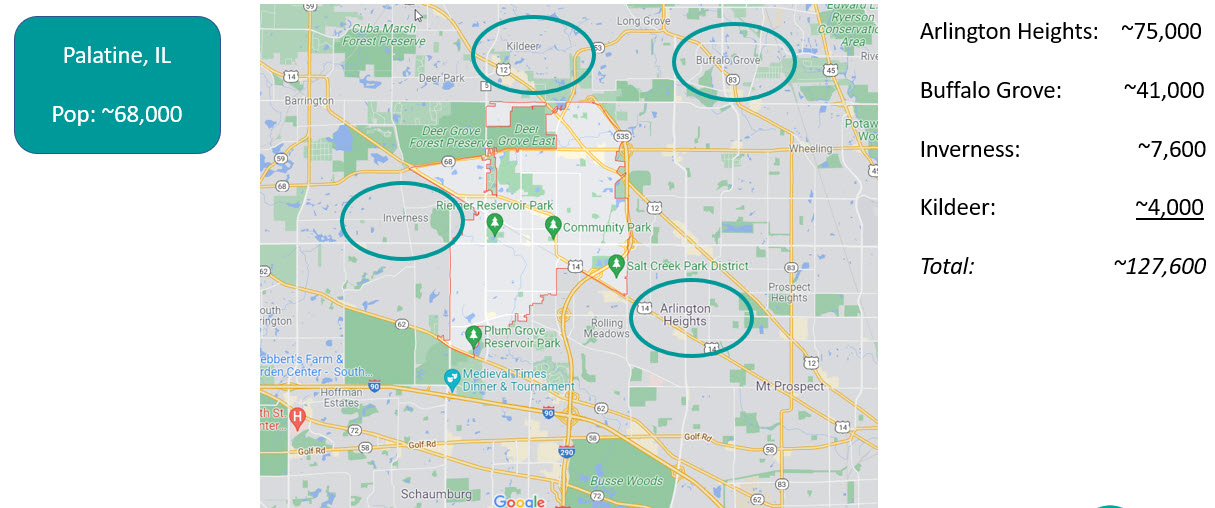
If your practice needs more than 68,000 people in this example, unless you take action, the people who are searching in these cities, whether they’re driving through, they live there, or they work there, aren’t going to know that you’re in Palatine because of this proximity bias.
When The Google Proximity Bias Hurts More
It gets even worse. Let’s imagine that you’re closer to somebody who’s searching for you, but they’re just in the next town over. You’re not going to show. Here’s our Palatine map again.
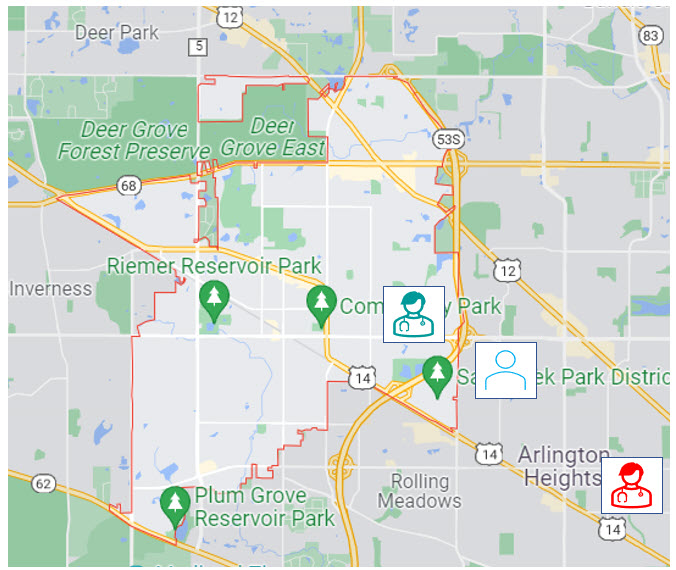
Let’s imagine now that your practice is in the Southeast corner, right next to Arlington Heights. The searcher is just across this highway, really close to you. And they’re searching for the services that you offer. But you’ve got a competitor down also in Arlington Heights who offers the same treatments and services more or less as you.
Unfortunately, unless you do something about it, your competitor has a much higher chance of showing up in their search results and you have practically no chance at all, just because you’re in the next town over. It’s as if Google has erected these invisible, very large, strong electrified fences. You might as well be on another planet unless you take action because Google is not going to show you.
It’s a shame because if this person values closeness also, and most people do, they would choose who is closer, but they’re not going to get shown you. So you both lose out simply because of the Google proximity bias.
Fighting Back Against The Google Proximity Bias
How do you fight back against the Google proximity bias? I’m going to give you a few ideas.
This is not an exhaustive list, but this is a good list.
- Online Organic Options
- Online Paid Options
- Offline Options (aka: Go Around Google)
Big Assumption!
There’s a big assumption, at least for the online options – your website and its SEO are solid.
That means your website is presentable. It’s professional. It’s not ugly. It’s not old. You’re going to be driving traffic to your website. You want it to look good. Just like if you wanted people to come to your office, you want your office to look good. Make sure that the SEO that underlies it is good. It’s foundational. You don’t have any big gaps. You’re not trying to win any SEO of the year awards, but you’ve got the basics in place so that when Google scans your site, it looks at it and goes, yeah, that practice is up to date. They look good. No harm to me (Google) showing you highly in search results because of your SEO.
Online Organic Option – A City Page
A really good one is a city page. They’re also called location pages or geo pages. So if you really like this option and you go hunting around for a marketing agency to help you use all three terms, city, location, geo pages, just to make sure you both are talking about the same thing you can do.
A city page is a page on your website that’s devoted to the target city that you’re going after. And really what it does is it screams to Google “I am a page about this city for this practice! I have a good website that is in the target city! I’m proximal to searchers in that city!”
The content that you put on the page includes specific info about the target city. You can talk a little bit about its history, local facts, local organizations. You’re also, of course, going to describe the services that you offer and what makes you different and valuable. And the SEO technicals are in place – the website page address, keywords, metas, linking, and other factors that any competent agency is going to know about.
City Page Example
This is an example that this picture that you see as a screenshot for one of our clients.
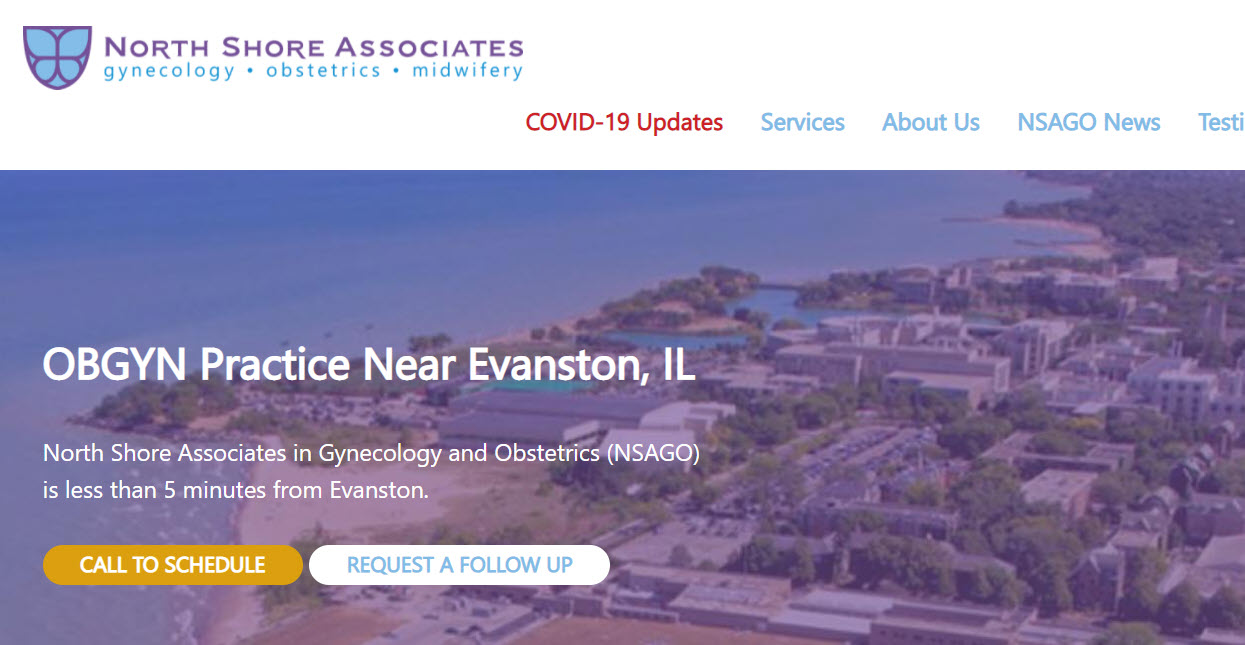
They are not in Evanston, Illinois, but man, oh man, are they close to Evanston, Illinois. Before we built this page, they might as well have been a world away. In fact, they’re so close to Evanston that they’re closer to a healthy chunk of the population of Evanston than other competitors of theirs that are based in Evanston. We launched it maybe a year ago. We drove a lot of traffic to it and we still do. We never stopped doing that. Now this page ranks on page one of search results in Evanston, even though we are not in Evanston, Illinois.
One caveat about building city pages – don’t build more than one page per city. Bad idea. It’s going to confuse Google. And when you confuse Google, Google responds by not ranking you highly. It doesn’t really know what else to do. Rather than having say two or three city pages for a city, have one page and fill it up with really good content.
The one exception to this is super large cities like Chicago or New York. In that case try to slice and dice it down into smaller sub geographies, like by a zip code or a neighborhood. If you do that only have one page per piece of geography that you work on. So that’s the first one.
Organic Paid Options – Google and Facebook Ads
Google ads or Facebook ads can be very effective, very quickly. Here’s the funny thing about Google – although the Google proximity bias is really, really strong with its organic search engine, if you pay Google for ads, they’ll show you anywhere you want. You can target a city, you can target a zip code, and your ads will be shown as long as you’ve got a really good ad agency who’s working on this on your behalf.
Facebook has the same options available. You can target cities or zips. There’s no proximity bias with Facebook, but the bias that Facebook does have is that it’s only going to show your posts, your organic posts, to friends or followers of the Facebook page only, and not even to all of them, just to a subset of them over time.
But if you pay Facebook, you can go right around that and show an ad pretty much anywhere you want, along with lots of other targeting data to get really, really granular if you want.
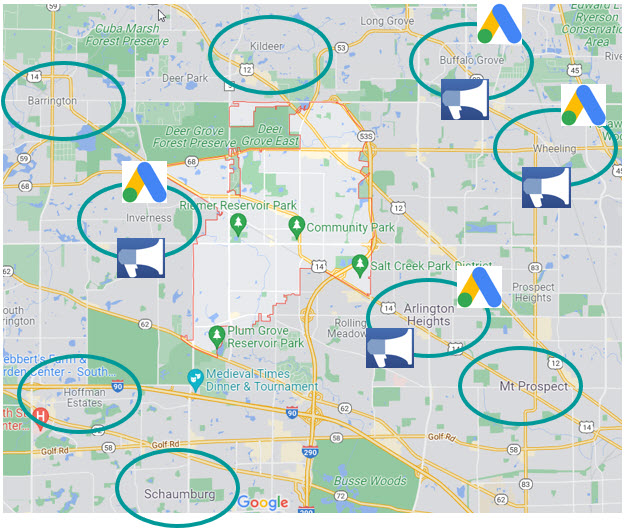
My recommendation for this, especially if you’re just getting started, is to be strategic. And what that means is don’t try to go everywhere at once. Pick one or two cities at a time and go deep, really entrench yourself in those cities so that people in those cities start to get to know you before you go onto more. Now, if you’ve got the resources to do more instead of picking one or two, then pick three or four more. But the point is don’t scatter the landscape and the countryside everywhere at once.
Go Around Google – Spend More Time In Your Target Cities
Give Presentations
So when it comes to outside of, Google and the online world devote time in cities outside of yours. Join a neighboring local chamber of commerce and get to know the people in there. You can give presentations to target patient types. Every town’s got a library and every can organize people for a certain topic that you could come up with. They’ve got the meeting space and all the equipment, and you can come give a presentation, very simple example, pick some target referring providers and really go after them.
Target Referring Providers
Pick one or two cities and target referring providers. Just keep going after them until you can get a meeting with them and until you establish a relationship with them. If you’re good at what you do, then eventually they’re going to benefit by sending patients to you because you’re going to treat their patients well and make them look good. They don’t always see it right away. It takes time.
Local Print Advertising
So direct mail advertising and local newspapers print has its place, and they can be pretty targeted.
You can get right down to the mail route or a neighborhood. You can pick more than one. One thing to keep in mind is that the conversion percentages are always low.
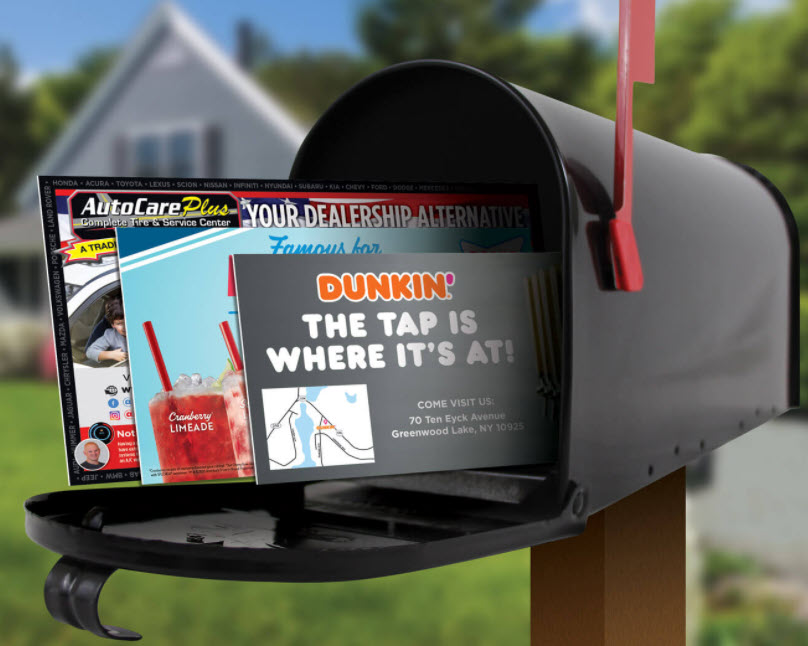
If you’re going to take this on the number one mistake I see is wanting to send one or two cards out, postcards out, or running one or two ads, and then stopping. People get frustrated when nothing happens. Think about the direct mail that you get. You probably don’t notice the first one or the second one, but if you have a need for something and a direct mail shows up and the timing matches and you like it, you might give them a call.
So the way to think about at least direct mail is if this is going to become part of your marketing plan, you need to do it throughout the year, say, once every other month or something like that over time, so that you, you start to break through the people. They start to recognize your name. Same thing with print advertising. It has be repetitive. You might get lucky, but usually you don’t and luck is not a strategy. You can’t plan luck.
Our library of Healthcare Marketing Rx videos grows. At MarketVisory Group we offer healthcare marketing systems that help you fight back. We also offer add-on services that can do the same. For more information about us and how we can help you out and to find more of the videos, go to marketvisorygroup.com.
